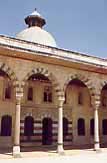Al-Azem palace, located south of the Umayyad Mosque near Suq al-Buzuriyya, was built in 1750 by the Ottoman governor of Damascus As'ad Pasha al-Azem. It is considered a great example of Damascene houses, one of most famous buildings of Old Damascus, and a typical example Syrian architecture.
The palace is divided into the haremlik, where the governor's family used to live. It is connected to a kitchen, a bath, and servant quarters; and the salamlik where the governor and other male members of the family would receive guests and conduct business. Along the south side of the salamlek is a well shaded liwan. The salamlek contains the formal halls, reception areas and courtyards with a beautiful fountain at the center of its marble floor. The courtyard is lined with trees and overhanging vines. The waters of Barada River were diverted to irrigate this garden.
The exterior facades display the traditional Damascene ablaq designs of alternating stripes of black and white stone. Other building materials, for example marble mosaics, carved stone openings with muqarnas corners, elaborate wooden paneling on the walls and the bedroom's painted wooden panel ceilings that display natural scenes, accentuate the overall impression of opulence. Roman columns from Bosra were brought in for the construction, as well as ancient paving from Banyas.
The palace was used as a residence of the Higher Commissioner during the early days of French mandate in 1920. It was later bought by the French authorities and changed into an educational institute. The palace was severely damaged by French bombardment during the Syrian Revolt of 1925. In 1954, the Palace was turned into a museum of Syrian tradition. Each room is designed and decorated to show some of the typical Damascene traditions, including preparation for Hajj and preparation for marriage.




